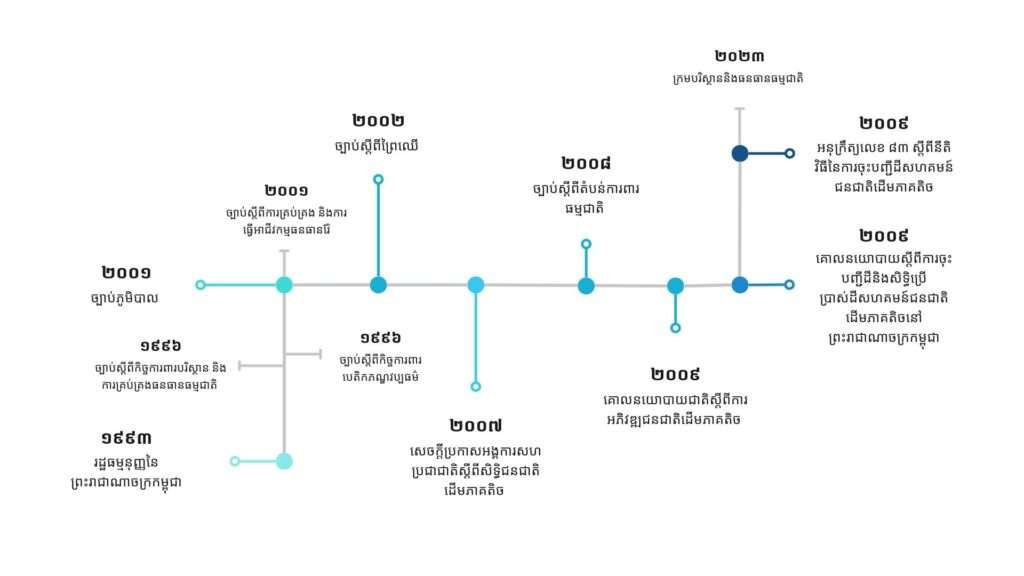ប្រទេសកម្ពុជាត្រូវបានគេស្គាល់តាមរយៈភាពសម្បូរបែបនៃវប្បធម៌ រួមទាំងជនជាតិភាគតិច និងសហគមន៍ជនជាតិដើមភាគតិច។ នៅពេលដែលប្រទេសរីកចម្រើន ការខិតខំប្រឹងប្រែងបានធ្វើឡើងដើម្បីទទួលស្គាល់ និងការពារសិទ្ធិរបស់ក្រុមទាំងនេះ តាមរយៈគោលនយោបាយ និងគំនិតផ្តួចផ្តើមនានាក្នុងការលើកកម្ពស់បរិយាបន្ន ការអភិរក្សបេតិកភណ្ឌវប្បធម៌ និងការដោះស្រាយបញ្ហាដូចជាសិទ្ធិដីធ្លីជាដើម។
“សហគមន៍ជនជាតិដើមភាគតិច គឺជាក្រុមមនុស្សដែលរស់នៅលើដែនដីនៃព្រះរាជាណាចក្រកម្ពុជាដែលសមាជិកទាំងអស់បង្ហាញនូវការឯកភាពនៃជាតិពន្ធុ សង្គមវប្បធម៌ និងសេដ្ឋកិច្ច ប្រតិបត្តិរបៀបរស់នៅតាមប្រពៃណី និងដាំដុះលើដីដែលខ្លួនកាន់កាប់ទៅតាមក្បួនខ្នាតទំនៀមទំលាប់នៃការប្រើប្រាស់ជាសមូហភាព” ផ្នែកទី២ អំពីអចលវត្ថុរបស់សហគមន៍ជនជាតិដើមភាគតិច មាត្រា ២៣ នៃច្បាប់ភូមិបាលឆ្នាំ២០០១។1

គោលនយោបាយ និងបញ្ញត្តិពាក់ព័ន្ធនឹងជនជាតិភាគតិច និងជនជាតិដើមភាគតិចនៅកម្ពុជា។ ផលិតដោយអង្គការអូឌីស៊ី ឆ្នាំ២០២៤។ ក្រោមអាជ្ញាប័ណ្ណ CC BY SA 4.0
រដ្ឋធម្មនុញ្ញនៃព្រះរាជាណាចក្រកម្ពុជា ឆ្នាំ១៩៩៣
រដ្ឋធម្មនុញ្ញបានទទួលស្គាល់សហគមន៍ចម្រុះជាតិសាសន៍របស់ប្រទេសកម្ពុជា។ មាត្រា ៣១ បានលើកឡើងថា ប្រជាពលរដ្ឋខ្មែរមានភាពស្មើគ្នាចំពោះមុខច្បាប់ មានសិទ្ធិសេរីភាព និងករណីកិច្ចដូចគ្នាទាំងអស់ ដោយឥតប្រកាន់ពូជសាសន៍ ពណ៌សម្បុរ ភេទ ភាសា ជំនឿសាសនា និន្នាការនយោបាយ ដើមកំណើតជាតិ ឋានៈសង្គម ធនធាន ឬស្ថានភាពឯទៀតឡើយ។ រដ្ឋធម្មនុញ្ញជាមូលដ្ឋានគ្រឹះសម្រាប់គោលនយោបាយការពារ និងលើកកម្ពស់សិទ្ធិជនជាតិភាគតិច និងជនជាតិដើមភាគតិច។ រដ្ឋធម្មនុញ្ញកំណត់គោលការណ៍ជាមូលដ្ឋានការពារសិទ្ធិរបស់បុគ្គល រួមបញ្ចូលការមិនរើសអើង សេរីភាពក្នុងការបង្កើតសមាគម សិទ្ធិទទួលបានកម្មសិទ្ធិអចលនទ្រព្យ ការអនុវត្តសេរីភាពនៃជំនឿ និងការផ្តល់ដំណោះស្រាយផ្លូវច្បាប់ក្នុងករណីមានការរំលោភសិទ្ធិ។2
ច្បាប់ភូមិបាល ឆ្នាំ២០០១
ច្បាប់ភូមិបាល និងច្បាប់ពាក់ព័ន្ធមានបទប្បញ្ញត្តិដែលទាក់ទងនឹងការកាន់កាប់ និងសិទ្ធិដីធ្លី ដោយបង្ហាញលើការធានាដីសម្រាប់សហគមន៍ជនជាតិដើមភាគតិច។ ការធានាបាននូវសិទ្ធិទទួលបានដោយសមធម៌ និងកម្មសិទ្ធិលើដីនៅតែជាធាតុផ្សំសំខាន់នៃគោលនយោបាយការពារជីវភាពរស់នៅរបស់សហគមន៍ទាំងនេះ។ ច្បាប់កំណត់យ៉ាងជាក់លាក់នូវជនជាតិដើមភាគតិច ការការពារសិទ្ធិរបស់ពួកគេក្នុងការគ្រប់គ្រងដីធ្លីរបស់ពួកគេតាមទំនៀមទម្លាប់ប្រពៃណី និងកំណត់គោលគំនិតនៃ “សិទ្ធិដីសមូហភាព” ។ យោងតាមមាត្រា ២៥ ដីសហគមន៍ជនជាតិដើមភាគតិចគឺជាដីទាំងអស់ដែលសហគមន៍បានរៀបចំនិវេសនដ្ឋាន និងប្រកបរបរកសិកម្មប្រពៃណី រួមទាំងការដូរវេនដំណាំដែលបានទទួលស្គាល់ដោយអាជ្ញាធររដ្ឋបាល។ មាត្រា ២៦ ចែងថារដ្ឋជាអ្នកដែលអាចផ្តល់ជូនកម្មសិទ្ធិសមូហភាពទៅសហគមន៍ ប៉ុន្តែសហគមន៍ គ្មានសិទ្ធិចាត់ចែងនូវចំណែកណាមួយនៃកម្មសិទ្ធិទៅឱ្យបុគ្គលឬក្រុមណាមួយបានឡើយ។3
ដើម្បីគាំទ្រ និងលម្អិតដំណើរការនៃការទទួលបានប័ណ្ណកម្មសិទ្ធិដីសមូហភាពជនជាតិដើមភាគតិច រដ្ឋាភិបាលបានអនុម័តគោលនយោបាយមួយស្តីពីការចុះបញ្ជីនិងសិទ្ធិប្រើប្រាស់ដីសហគមន៍ជនជាតិដើមភាគតិចនៅកម្ពុជា អនុក្រឹត្យលេខ ៨៣ ស្តីពីនីតិវិធីនៃការចុះបញ្ជីដីសហគមន៍ជនជាតិដើមភាគតិច និងគោលនយោបាយជាតិស្តីពីការអភិវឌ្ឍជនជាតិដើមភាគតិច។4
ច្បាប់ស្តីពីព្រៃឈើ ឆ្នាំ២០០២
ច្បាប់នេះផ្តល់នូវក្របខ័ណ្ឌសម្រាប់ការគ្រប់គ្រងព្រៃឈើ ការប្រមូលផល ការប្រើប្រាស់ ការអភិវឌ្ឍ និងការអភិរក្ស។ គួរកត់សម្គាល់ថា ច្បាប់នេះរួមបញ្ចូលបទប្បញ្ញត្តិជាក់លាក់ដែលគ្រប់គ្រងការប្រើប្រាស់ព្រៃឈើដោយជនជាតិដើមភាគតិចដែលត្រូវបានចុះបញ្ជីក្រោមបទប្បញ្ញត្តិជាធរមាន។5
សេចក្តីប្រកាសអង្គការសហប្រជាជាតិស្តីពីសិទ្ធិជនជាតិដើមភាគតិច ឆ្នាំ២០០៧
ព្រះរាជាណាចក្រកម្ពុជា បានចូលរួមបោះឆ្នោតគាំទ្រសេចក្តីប្រកាសរបស់អង្គការសហប្រជាជាតិស្តីពីសិទ្ធិជនជាតិដើមភាគតិចនៅក្នុងឆ្នាំ២០០៧។ សេចក្តីប្រកាសនេះជាឯកសារអន្តរជាតិដ៏ទូលំទូលាយបំផុតដែលបង្ហាញពីសិទ្ធិរបស់សហគមន៍ជនជាតិដើមភាគតិច។ វាបង្កើតស្តង់ដារអប្បបរមាសម្រាប់ការទទួលស្គាល់ ការការពារ និងការលើកកម្ពស់សិទ្ធិទាំងនេះ ដោយបង្ហាញពីក្របខ័ណ្ឌមួយដែលគ្របដណ្តប់ទាំងសិទ្ធិបុគ្គល និងសមូហភាព។ សេចក្តីប្រកាសគ្របដណ្តប់លើប្រធានបទដូចជាអត្តសញ្ញាណវប្បធម៌ ការអប់រំ សុខភាព ការងារ និងសិទ្ធិភាសា។ សេចក្តីប្រកាសនេះហាមប្រាមការរើសអើង ហើយតស៊ូមតិសម្រាប់ការចូលរួមយ៉ាងពេញលេញរបស់ជនជាតិដើមភាគតិចក្នុងនយោបាយ សេដ្ឋកិច្ច សង្គម និងវប្បធម៌។ សេចក្តីប្រកាសនេះការពារសិទ្ធិរបស់ពួកគេក្នុងការរក្សាភាពខុសប្លែកគ្នា ខណៈពេលដែលបន្តស្វែងរកអាទិភាពនៃការអភិវឌ្ឍ។6
ច្បាប់ស្តីពីតំបន់ការពារធម្មជាតិ ឆ្នាំ២០០៨
ច្បាប់នេះបង្កើតក្របខ័ណ្ឌដ៏ទូលំទូលាយមួយសម្រាប់ការគ្រប់គ្រង ការអភិរក្ស និងការអភិវឌ្ឍតំបន់ការពារ ជាមួយនឹងគោលដៅចម្បងនៃការធានាការគ្រប់គ្រងជីវចម្រុះ ការអភិរក្ស និងការប្រើប្រាស់ប្រកបដោយនិរន្តរភាពនៃធនធានធម្មជាតិនៅក្នុងតំបន់ដែលបានកំណត់។ ជំពូកទី៦ រៀបរាប់អំពីការចូលរួមរបស់សហគមន៍ជនជាតិដើមភាគតិច និងសិទ្ធិចូលប្រើប្រាស់នៅក្នុងតំបន់ការពារ។7
នៅឆ្នាំ២០២២ រដ្ឋាភិបាលបានដាក់ចេញនូវវិសោធនកម្មច្បាប់ផ្សេងៗ រួមទាំងច្បាប់ស្តីពីតំបន់ការពារធម្មជាតិផងដែរ។ ច្បាប់បច្ចុប្បន្នទទួលស្គាល់ និងធានាការចូលប្រើប្រាស់តាមប្រពៃណី ទំនៀមទម្លាប់ ជំនឿ និងសាសនារបស់ជនជាតិដើមភាគតិចដែលរស់នៅក្នុង និងនៅជាប់តំបន់ការពារ។ ច្បាប់ក៏ធានានូវការចូលរួមរបស់ពួកគេក្នុងការសម្រេចចិត្តទាក់ទងនឹងការគ្រប់គ្រងប្រកបដោយនិរន្តរភាព និងការអភិរក្សជីវៈចម្រុះ។ ទោះជាយ៉ាងណាក៏ដោយ វិសោធនកម្មដែលបានស្នើរសុំបានដកចេញនូវឯកសារយោងជាក់លាក់ចំពោះជនជាតិដើមភាគតិច ដោយជំនួសពួកគេដោយ “សហគមន៍មូលដ្ឋាន” ដែលអាចនឹងមានផលប៉ះពាល់លើសិទ្ធិរបស់ពួកគេ ដូចមានចែងនៅក្នុងសេចក្តីប្រកាសអង្គការសហប្រជាជាតិស្តីពីសិទ្ធិជនជាតិដើមភាគតិច។8
គោលនយោបាយជាតិស្តីពីការអភិវឌ្ឍជនជាតិដើមភាគតិច ឆ្នាំ២០០៩
គោលនយោបាយនេះបំពេញបន្ថែមលើច្បាប់ភូមិបាលជាមួយនឹងគោលដៅចម្បងនៃការការពារសិទ្ធិជនជាតិដើមភាគតិចយ៉ាងទូលំទូលាយ រួមទាំងការទទួលស្គាល់សិទ្ធិរបស់ពួកគេក្នុងការកាន់កាប់កម្មសិទ្ធិសមូហភាព។ គោលនយោបាយ រៀបរាប់លម្អិតអំពីជំហានដែលសហគមន៍ជនជាតិដើមភាគតិចត្រូវធ្វើដើម្បីទទួលបានប័ណ្ណកម្មសិទ្ធិដីសមូហភាព។ លើសពីនេះ គោលនយោបាយមានគោលបំណងលើកកម្ពស់គុណភាពជីវិតរបស់សហគមន៍ជនជាតិដើមភាគតិច ដោយកាត់បន្ថយភាពអត់ឃ្លាន និងភាពក្រីក្រ និងធានាឱ្យមានការអប់រំផ្លូវការ វគ្គបណ្តុះបណ្តាលវិជ្ជាជីវៈ និងសេវាថែទាំសុខភាពយ៉ាងតិចប្រាំបួនឆ្នាំ។ គោលនយោបាយនេះក៏ការពារ និងអភិរក្សបេតិកភណ្ឌវប្បធម៌របស់ជនជាតិដើមភាគតិចផងដែរ។9
គោលនយោបាយស្តីពីការចុះបញ្ជីដីនិងសិទ្ធិប្រើប្រាស់ដីសហគមន៍ជនជាតិដើមភាគតិចនៅព្រះរាជាណាចក្រកម្ពុជា ឆ្នាំ២០០៩
នៅឆ្នាំ២០០៩ រដ្ឋាភិបាលបានចេញគោលនយោបាយស្តីពីការចុះបញ្ជីដីនិងសិទ្ធិប្រើប្រាស់ដីសហគមន៍ជនជាតិដើមភាគតិច ដើម្បីគាំទ្រការផ្តល់ប័ណ្ណកម្មសិទ្ធិសមូហភាពជនជាតិដើមភាគតិចនៅកម្ពុជា។ គោលនយោបាយនេះមានគោលបំណងចុះបញ្ជីដីសមូហភាពជនជាតិដើមភាគតិច ដើម្បីធានាការកាន់កាប់ដីធ្លី កាត់បន្ថយភាពក្រីក្រ លើកកម្ពស់ការអភិវឌ្ឍសេដ្ឋកិច្ចជាតិ លុបបំបាត់ការកាប់រានព្រៃឈើខុសច្បាប់ និងការទន្ទ្រានយកដី និងថែរក្សាសម្បត្តិវប្បធម៌របស់ព្រះរាជាណាចក្រកម្ពុជា។10
អនុក្រឹត្យលេខ ៨៣ ស្តីពីនីតិវិធីនៃការចុះបញ្ជីដីសហគមន៍ជនជាតិដើមភាគតិច ឆ្នាំ២០០៩
រដ្ឋាភិបាលបានអនុម័តជាផ្លូវការនូវអនុក្រឹត្យលេខ ៨៣ ដែលគូសបញ្ជាក់អំពីក្របខ័ណ្ឌនីតិវិធីសម្រាប់ការចុះបញ្ជីដីសមូហភាពជនជាតិដើមភាគតិចក្នុងឆ្នាំ២០០៩។ អនុក្រឹត្យនេះពិពណ៌នាយ៉ាងច្បាស់លាស់អំពីដំណើរការផ្សេងៗដែលពាក់ព័ន្ធនឹងការទទួលបានប័ណ្ណកម្មសិទ្ធិសមូហភាព។11
ច្បាប់ និងបទប្បញ្ញត្តិពាក់ព័ន្ធផ្សេងទៀត
- ច្បាប់ស្តីពីកិច្ចការពារបេតិកភណ្ឌវប្បធម៌ ឆ្នាំ១៩៩៦
- ច្បាប់ស្តីពីកិច្ចការពារបរិស្ថាន និងការគ្រប់គ្រងធនធានធម្មជាតិ ឆ្នាំ១៩៩៦
- ច្បាប់ស្តីពីការគ្រប់គ្រង និងការធ្វើអាជីវកម្មធនធានរ៉ែ ឆ្នាំ២០០១
- ក្រមបរិស្ថាននិងធនធានធម្មជាតិ ឆ្នាំ២០២៣
ទាក់ទងនឹងគោលនយោបាយ និងសិទ្ធិជនជាតិភាគតិច និងជនជាតិដើមភាគតិច
ឯកសារយោង
- 1. ច្បាប់ភូមិបាលឆ្នាំ២០០១, មាត្រា ២៣។
- 2. រដ្ឋធម្មនុញ្ញនៃព្រះរាជាណាចក្រកម្ពុជា ឆ្នាំ២០០៨, មាត្រា ៣១។
- 3. ច្បាប់ភូមិបាលឆ្នាំ២០០១, មាត្រា ២៦។
- 4. ដូចឯកសារយោងខាងលើ។
- 5. ច្បាប់ស្តីពីព្រៃឈើ ឆ្នាំ២០០២។
- 6. សេចក្តីប្រកាសអង្គការសហប្រជាជាតិស្តីពីសិទ្ធិជនជាតិដើមភាគតិច ឆ្នាំ២០០៧។
- 7. ច្បាប់ស្តីពីតំបន់ការពារធម្មជាតិ ឆ្នាំ២០០៨, ជំពូកទី៦។
- 8. ក្រុមការងារអន្តរជាតិស្តីពីកិច្ចការជនជាតិដើមភាគតិច (IWGIA), “ពិភពលោកជនជាតិដើមភាគតិច ២០២៣៖ កម្ពុជា,” ថ្ងៃទី២៨ ខែមីនា ឆ្នាំ២០២៣ បានចូលអាននៅថ្ងៃទី១៨ ខែមករា ឆ្នាំ២០២៤។
- 9. គោលនយោបាយជាតិស្តីពីការអភិវឌ្ឍជនជាតិដើមភាគតិច ឆ្នាំ២០០៩។
- 10. គោលនយោបាយស្តីពីការចុះបញ្ជីដីនិងសិទ្ធិប្រើប្រាស់ដីសហគមន៍ជនជាតិដើមភាគតិចនៅព្រះរាជាណាចក្រកម្ពុជា ឆ្នាំ២០០៩។
- 11. អនុក្រឹត្យលេខ ៨៣ ស្តីពីនីតិវិធីនៃការចុះបញ្ជីដីសហគមន៍ជនជាតិដើមភាគតិច ឆ្នាំ២០០៩។

